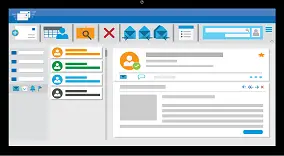When writing an email you must put a salutation. No matter if you know the recipient’s name, you must have a salutation in your email. Sometimes you may only know the name of the company you are writing to or the department, and sometimes you may not have a clue which department, or person you are addressing. For these cases, we have prepared some salutations you can use in different situations.
Since you are writing to a stranger, remember that your email should be in a standard font such as Calibri, Arial, or Times New Roman. For more formal emails, you need to observe certain writing ethics.
Another important requirement is to have a closing line like Regards, Best wishes, Sincerely at the end of the email.
How To Address An Email To An Unknown person
Before you write your email, the most important thing is to look for an email to address your email to, look on the company’s website or make a phone call. In many cases, you will find some general email left on the website (such as info@, sales@ support@, etc).
When writing an email to someone you don’t know you can use these salutations:
1. To whom it may concern – is a more formal way to start communication with a stranger;
2. Hi there – is more informal and can be used when writing a more friendly or less formal email;
3. Greetings – is also another alternative and conveys a welcoming feeling;
4. Good Morning or Good Afternoon – is also a polite way to start your email. This shows that you don’t want to hastily write another email or use the ready-made template starting with Hello, but that you’ve made an effort to write what the specific time is – morning or afternoon;
5. Dear Sir or Madam – is the most formal way to greet someone you don’t know;
6. or simply saying Hello – is the most common form of greeting someone you don’t know. When you are in a hurry and can think of no other phrase, simply and clearly use Hello;
*TIP* In your initial email simply ask who you can reach to provide you with the correct contact. This approach is safer to get feedback. In many cases where an inquiry has not gone to the right person, it’s ignored. To avoid the same thing happening to you simply ask who would be the best person to contact. Here is an example:
To whom it may concern,
I’m writing you on behalf of company (NAME). We would be grateful if you would quote us your lowest rate for 100 licenses of (ITEM NAME)?
We look forward to receiving your quotation as soon as possible.
Yours sincerely,
Peter
If you know that they are your customer, but do not have any contact from the company you can write ”Dear Customer”.
If you know the team you need to contact, you can write ”Dear HR Team” or ”Dear Sales Team”.
How To Address An Email To A Company
Approaching someone from across the company with no idea who it might be, from which department is quite strange. Yeah, but that’s how it always is on first contact. Once you get some sort of response you can address that person by name (which is most advisable).
The most common greetings are:
1. Dear Customer,
2. Dear Valued Customer,
3. Hello,
How To Address An Email To A Department
Well, once you at least have an idea of which department you need to contact you will be able to use a more specific salutation like:
1. Dear Team,
2. Dear Finance Team,
3. Dear Colleagues,
How To Address An Email To Two People
When an email needs to be addressed to two people it is the same as addressing it to one person but adding another name. You can use the following greetings:
1. Dear Sam, James,
2. Dear All,
3. Good Morning Sam and James,
4. First, mention the first person with @(NAME), and after that mention the other person:
Hi @Liam,
Can you please take this up and confirm once it’s completed?
Hi @Jessica,
Let us know if there is any change in the payment runs.
This way you will distribute the tasks and there will be no confusion about who has to do what.
*TIP* When you write your email don’t forget someone in CC:. They both need to be in To:
Overall
Remember that your email must contain – a subject line, salutation, body, and your signature. The salutation is an important part, but if your subject line is not clear or the body is structured incorrectly you will lose the other party.









